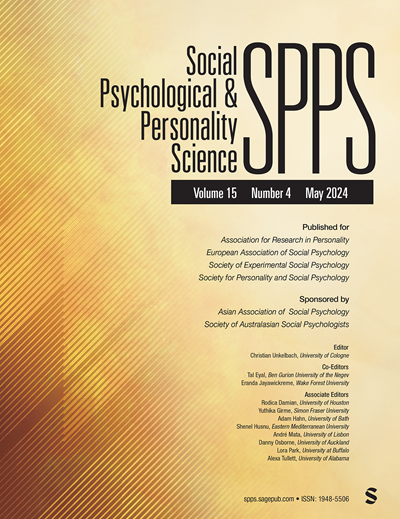方法不等于方法
IF 4.3
2区 心理学
Q1 PSYCHOLOGY, SOCIAL
引用次数: 27
摘要
关于愤怒的脸是否会引起接近或回避倾向,证据并不一致。本研究试图解决这一争论。我们认为避近运动可以服务于不同的目标(例如,隶属关系,攻击)。此外,我们假设这些目标决定了愤怒面孔对接近回避倾向的影响。特别是,愤怒的脸传达了攻击意图,因此可能在感知者中唤起攻击倾向。因此,愤怒的面孔只有在服务于攻击性时才会触发接近,而在服务于从属关系时则不会。三项研究表明,当行为被表现为攻击性行为时,愤怒的脸会促进行为,而当行为被表现为和平行为时则不会。此外,当方法被表示为和平方法,因此,侵略不是一个可用的选择时,愤怒的脸促进了回避。总之,愤怒的脸可以引起接近或回避,这取决于与这些行为相关的目标。本文章由计算机程序翻译,如有差异,请以英文原文为准。
Approach Does Not Equal Approach
There is inconsistent evidence as to whether angry faces evoke approach or avoidance tendencies. The present research sought to resolve this debate. We suggest that approach–avoidance movements can serve various goals (e.g., affiliation, aggression). Furthermore, we assume that these goals determine the effect of angry faces on approach–avoidance tendencies. In particular, angry faces communicate aggressive intentions and may therefore evoke aggressive tendencies in the perceiver. Thus, angry faces should trigger approach only when it serves aggression but not when it serves affiliation. Three studies showed that angry faces facilitated approach, when the behavior was represented as aggressive approach, but not when it was represented as peaceful approach. Furthermore, when approach was represented as peaceful approach and, hence, aggression was not an available option, angry faces facilitated avoidance. In sum, angry faces can evoke approach or avoidance, depending on the goals associated with these behaviors.
求助全文
通过发布文献求助,成功后即可免费获取论文全文。
去求助
来源期刊

Social Psychological and Personality Science
PSYCHOLOGY, SOCIAL-
CiteScore
12.50
自引率
1.80%
发文量
77
期刊介绍:
Social Psychological and Personality Science (SPPS) is a distinctive journal in the fields of social and personality psychology that focuses on publishing brief empirical study reports, typically limited to 5000 words. The journal's mission is to disseminate research that significantly contributes to the advancement of social psychological and personality science. It welcomes submissions that introduce new theories, present empirical data, propose innovative methods, or offer a combination of these elements. SPPS also places a high value on replication studies, giving them serious consideration regardless of whether they confirm or challenge the original findings, with a particular emphasis on replications of studies initially published in SPPS. The journal is committed to a rapid review and publication process, ensuring that research can swiftly enter the scientific discourse and become an integral part of ongoing academic conversations.
 求助内容:
求助内容: 应助结果提醒方式:
应助结果提醒方式:


